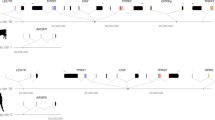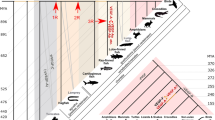Abstract
The relaxin gene family is a group of genes involved in different physiological roles, most of them related to reproduction. In vertebrates the genes in this family are located in three separate chromosomal locations, and have been called relaxin family locus (RFL) A, B, and C. Among mammals the RFLA and RFLC are the most conserved as no gene copy-number variation has been observed thus far. The RFLB locus is also conserved on most mammals other than primates, where there are several gene gains and losses. Interestingly, the relaxin gene found on the RFLB locus in the European rabbit has acquired a novel role. In addition to the classical reproductive roles, this gene is expressed in tracheobronchial epithelial cells and its expression has been linked to squamous differentiation. We reconstructed the evolutionary history of the European rabbit RFLB locus using the tools of comparative genomics and molecular evolution. We found that the European rabbit possess a RFLB locus which is unique among mammals in that there are five tandemly arranged relaxin gene copies, which contrast with the single relaxin copy gene found in most mammals. In addition we also found that the ancestral pre-duplication gene was subject to the action of positive selection, and several amino acid sites were identified under the action of natural selection including the sites B12 and B13 which are part of the receptor recognition and binding site.




Similar content being viewed by others
References
Arroyo JI, Hoffmann FG, Opazo JC (2012) Gene turnover and differential retention in the relaxin/insulin-like gene family in primates. Molecular Phylogenetics and Evolution (in press)
Bani D (1997) Relaxin: a pleiotropic hormone. Gen Pharmacol 28:13
Bani D, Nistri S, Sacchi TB, Bigazzi M (2005) Basic progress and future therapeutic perspectives of relaxin in ischemic heart disease. Ann N Y Acad Sci 1041:423
Bathgate RA, Ivell R, Sanborn BM, Sherwood OD, Summers RJ (2006) International Union of Pharmacology LVII: recommendations for the nomenclature of receptors for relaxin family peptides. Pharmacol Rev 58:7
Bièche I, Laurent A, Laurendeau I, Duret L, Giovangrandi Y, Frendo J-L, Olivi M, Fausser J-L, Dl Evain-Brion, Vidaud M (2003) Placenta-specific INSL4 expression is mediated by a human endogenous retrovirus element. Biol Reprod 68:1422
Burger LL, Sherwood OD (1995) Evidence that cellular proliferation contributes to relaxin-induced growth of both the vagina and the cervix in the pregnant rat. Endocrinology 136:4820
Do CB, Mahabhashyam MS, Brudno M, Batzoglou S (2005) ProbCons: probabilistic consistency-based multiple sequence alignment. Genome Res 15:330
Dschietzig T, Bartsch C, Baumann G, Stangl K (2006) Relaxin-a pleiotropic hormone and its emerging role for experimental and clinical therapeutics. Pharmacol Ther 112:38
Edgar RC (2004) MUSCLE: a multiple sequence alignment method with reduced time and space complexity. BMC Bioinf 5:113
Fields PA, Fields MJ (2005) Potential binding sites for the relaxin in pregnant rabbits. Ann NY Acad Sci 1041:123
Fields P, Kondo S, Tashima L, Bryant-Greenwood G, Greenwood F (1995) Expression of SQ10 (a preprorelaxin-like gene) in the pregnant rabbit placenta and uterus. Biol Reprod 53:1139
Goodman M (1981) Decoding the pattern of protein evolution. Prog Biophys Molec Biol 37:105
Goodman M (1982) Positive selection causes purifying selection. Nature 295:630
Graham EF, Dracy AE (1953) The effect of relaxin and mechanical dilatation of the bovine cervix. J Dairy Sci 36:772
Hahn MW (2009) Distinguishing among evolutionary models for the maintenance of gene duplicates. J Hered 100:605
Hall K (1947) The effects of pregnancy and relaxin on the histology of the pubic symphysis in the mouse. J Endocrinol 5:174
Hallstrom BM, Janke A (2008) Resolution among major placental mammal interordinal relationships with genome data imply that speciation influenced their earliest radiations. BMC Evol Biol 8:162
Hallstrom BM, Janke A (2010) Mammalian evolution may not be strictly bifurcating. Mol Biol Evol 27:2804
Hoffmann FG, Opazo JC (2011) Evolution of the relaxin/insulin-like gene family in placental mammals: implications for its early evolution. J Mol Evol 72:72
Innan H, Kondrashov F (2010) The evolution of gene duplications: classifying and distinguishing between models. Nat Rev Genet 11:97
Jetten AM, Bernacki SH, Floyd EE, Saunders NA, Pieniazek J, Lotan R (1992) Expression of a preprorelaxin-like gene during squamous differentiation of rabbit tracheobronchial epithelial cells and its suppression by retinoic acid. Cell Growth Differ 3:549
Jobb G, Av Haeseler, Strimmer K (2004) TREEFINDER: a powerful graphical analysis environment for molecular phylogenetics. BMC Evol Biol 4:18
Kamat AA, Feng S, Agoulnik IU, Kheradmand F, Bogatcheva NV, Coffey D, Sood AK, Agoulnik AI (2006) The role of relaxin in endometrial cancer. Cancer Biol Ther 5:71
Katoh K, Asimenos G, Toh H (2009) Multiple alignment of DNA sequences with MAFFT. Methods Mol Biol 537:39
Krantz JC, Bryant HH, Carr CJ (1950) The action of aqueous corpus luteum extract upon uterine activity. Surg Gynecol Obstet 90:372
Lassmann T, Sonnhammer EL (2005) Automatic assessment of alignment quality. Nucleic Acids Res 33:7120
Lassmann T, Frings O, Sonnhammer EL (2009) Kalign2: high-performance multiple alignment of protein and nucleotide sequences allowing external features. Nucleic Acids Res 37:858
Nielsen R, Yang Z (1998) Likelihood models for detecting positively selected amino acid sites and applications to the HIV-1 envelope gene. Genetics 148:929
Notredame C, Higgins DG, Heringa J (2000) T-Coffee: a novel method for fast and accurate multiple sequence alignment. J Mol Biol 302:205
O’Day MB, Winn RJ, Easter RA, Dziuk PJ, Sherwood OD (1989) Hormonal control of the cervix in pregnant gilts. II. Relaxin promotes changes in the physical properties of the cervix in ovariectomized hormone-treated pregnant gilts. Endocrinology 125:3004
Ohno S (1970) Evolution by gene duplication. Springer-Verlag, New York
Park J-I, Semyonov J, Chang CL, Yi W, Warren W, Hsu SYT (2008a) Origin of INSL3-mediated testicular descent in therian mammals. Genome Res 18:974
Park J-I, Semyonov J, Yi W, Chang CL, Hsu SYT (2008b) Regulation of receptor signaling by relaxin A chain motifs: derivation of pan-specific and LGR7-specific human relaxin analogs. J Biol Chem 283:32099
Ronquist F, Huelsenbeck JP (2003) MrBayes 3: bayesian phylogenetic inference under mixed models. Bioinformatics 19:1572
Samuel CS (2005) Relaxin: antifibrotic properties and effects in models of disease. Clin Med Res 3:241
Samuel CS, Hewitson TD (2006) Relaxin in cardiovascular and renal disease. Kidney Int 69:1498
Samuel CS, Du XJ, Bathgate RA, Summers RJ (2006) ‘Relaxin’ the stiffened heart and arteries: the therapeutic potential for relaxin in the treatment of cardiovascular disease. Pharmacol Ther 112:529
Samuel CS, Hewitson TD, Unemori EN, Tang ML (2007) Drugs of the future: the hormone relaxin. Cell Mol Life Sci 64:1539
Sawyer SA (1989) Statistical tests for detecting gene conversion. Mol Biol Evol 6:526
Shabanpoor F, Separovic F, Wade JD (2009) The human insulin superfamily of polypeptide hormones. In: Litwack G (ed) Insulin and IGFs. Academic Press, London, pp 1–31
Sherwood OD (2004) Relaxin’s physiological roles and other diverse actions. Endocr Rev 25:205
Sherwood CD, O’Byrne EM (1974) Purification and characterization of porcine relaxin. Arch Biochem Biophys 160:185
Silvertown JD, Summerlee AJ, Klonisch T (2003) Relaxin-like peptides in cancer. Int J Cancer 107:513
Subramanian AR, Kaufmann M, Morgenstern B (2008) DIALIGN-TX: greedy and progressive approaches for segment-based multiple sequence alignment. Algorithms Mol Biol 3:6
Tatusova TA, Madden TL (1999) BLAST 2 sequences, a new tool for comparing protein and nucleotide sequences. FEMS Microbiol Lett 174:247
Wilkinson TN, Speed TP, Tregear GW, Bathgate RAD (2005) Evolution of the relaxin-like peptide family. BMC Evol Biol 5:14
Yang Z (2007) PAML 4: phylogenetic analysis by maximum likelihood. Mol Biol Evol 24:1586
Yang Z, dos Reis M (2011) Statistical properties of the branch-site test of positive selection. Mol Biol Evol 28:1217
Yang Z, Nielsen R, Goldman N, Pedersen AM (2000) Codon-substitution models for heterogeneous selection pressure at amino acid sites. Genetics 155:431
Yang Z, Wong WS, Nielsen R (2005) Bayes empirical bayes inference of amino acid sites under positive selection. Mol Biol Evol 22:1107
Zhang J (2003) Evolution by gene duplication: an update. Trends Ecol Evol 18:292
Zhang J, Nielsen R, Yang Z (2005) Evaluation of an improved branch-site likelihood method for detecting positive selection at the molecular level. Mol Biol Evol 22:2472
Zhao L, Samuel CS, Tregear GW, Beck F, Wintour EM (2000) Collagen studies in late pregnant relaxin null mice. Biol Reprod 63:697
Acknowledgments
This study was funded by grants to JCO from the Fondo Nacional de Desarrollo Científico y Tecnológico (FONDECYT 11080181), Programa Bicentenario de Ciencia y Tecnología (PSD89), and the Oliver Pearson Award from the American Society of Mammalogists (ASM). FGH acknowledges a grant from the National Science Foundation (EPS-0903787).
Author information
Authors and Affiliations
Corresponding author
Electronic supplementary material
Below is the link to the electronic supplementary material.
Rights and permissions
About this article
Cite this article
Arroyo, J.I., Hoffmann, F.G. & Opazo, J.C. Gene Duplication and Positive Selection Explains Unusual Physiological Roles of the Relaxin Gene in the European Rabbit. J Mol Evol 74, 52–60 (2012). https://doi.org/10.1007/s00239-012-9487-2
Received:
Accepted:
Published:
Issue Date:
DOI: https://doi.org/10.1007/s00239-012-9487-2




